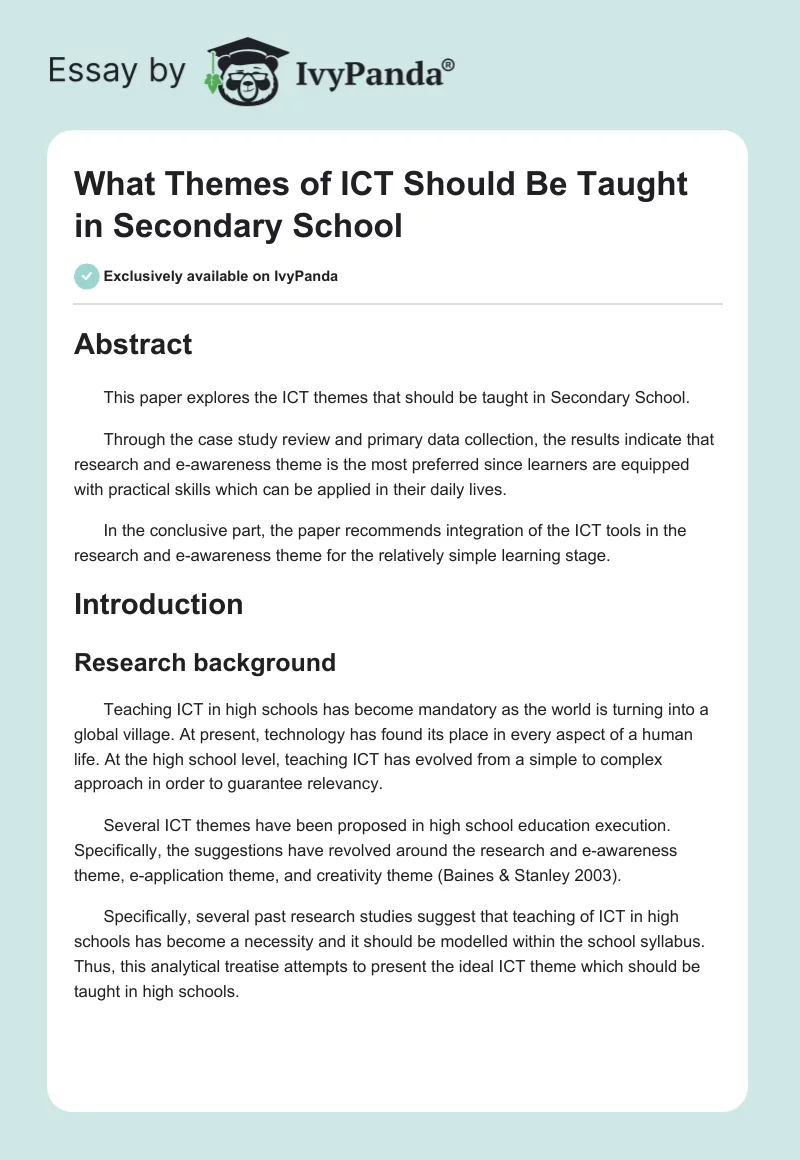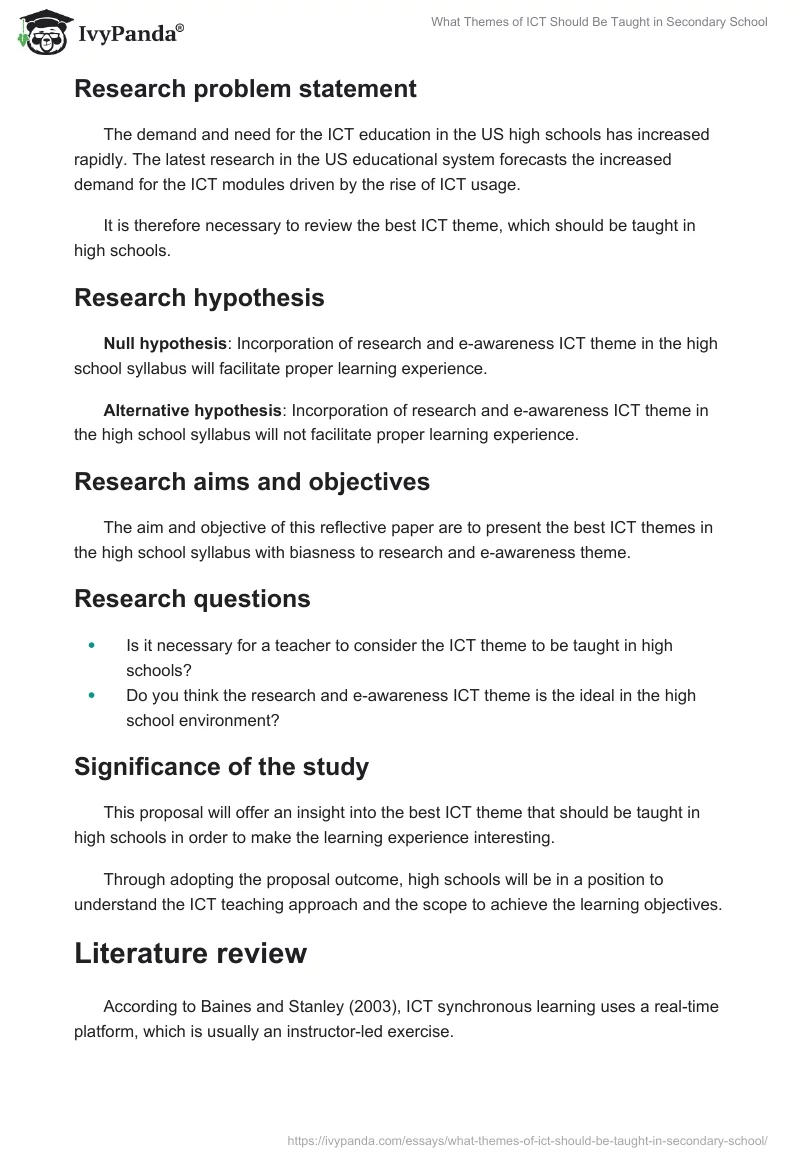Abstract
This paper explores the ICT themes that should be taught in Secondary School.
Through the case study review and primary data collection, the results indicate that research and e-awareness theme is the most preferred since learners are equipped with practical skills which can be applied in their daily lives.
In the conclusive part, the paper recommends integration of the ICT tools in the research and e-awareness theme for the relatively simple learning stage.
Introduction
Research background
Teaching ICT in high schools has become mandatory as the world is turning into a global village. At present, technology has found its place in every aspect of a human life. At the high school level, teaching ICT has evolved from a simple to complex approach in order to guarantee relevancy.
Several ICT themes have been proposed in high school education execution. Specifically, the suggestions have revolved around the research and e-awareness theme, e-application theme, and creativity theme (Baines & Stanley 2003).
Specifically, several past research studies suggest that teaching of ICT in high schools has become a necessity and it should be modelled within the school syllabus. Thus, this analytical treatise attempts to present the ideal ICT theme which should be taught in high schools.
Research problem statement
The demand and need for the ICT education in the US high schools has increased rapidly. The latest research in the US educational system forecasts the increased demand for the ICT modules driven by the rise of ICT usage.
It is therefore necessary to review the best ICT theme, which should be taught in high schools.
Research hypothesis
Null hypothesis: Incorporation of research and e-awareness ICT theme in the high school syllabus will facilitate proper learning experience.
Alternative hypothesis: Incorporation of research and e-awareness ICT theme in the high school syllabus will not facilitate proper learning experience.
Research aims and objectives
The aim and objective of this reflective paper are to present the best ICT themes in the high school syllabus with biasness to research and e-awareness theme.
Research questions
- Is it necessary for a teacher to consider the ICT theme to be taught in high schools?
- Do you think the research and e-awareness ICT theme is the ideal in the high school environment?
Significance of the study
This proposal will offer an insight into the best ICT theme that should be taught in high schools in order to make the learning experience interesting.
Through adopting the proposal outcome, high schools will be in a position to understand the ICT teaching approach and the scope to achieve the learning objectives.
Literature review
According to Baines and Stanley (2003), ICT synchronous learning uses a real-time platform, which is usually an instructor-led exercise.
Examples of synchronous learning include virtual classrooms, internet telephony, video and audio conferencing, and two-way live satellite broadcasts whereby lecturers can communicate with students in a classroom (Baines & Stanley 2003).
Over the past decade, the ICT program has emerged as a new syllabus in the high school education. This has been made possible by the emergence and advancement of information communication and technology.
The risk associated with the current ICT teaching approaches can be countered through technical countermeasures in the comprehensive research and e-awareness theme (Sizer 1996).
Some of these measures cover proper authorization and modification of the research and e-awareness theme to suit different high school learning environments.
Methodology
Research methods
This research used a deductive research approach because of its applicability in collecting a large volume of data, as was required for this research. The research work was structured in order to move from general to more specific.
Therefore, discussion was first modified to address ICT teaching in high schools as a concept, and then the implications of the research and e-awareness theme for students’ learning, before narrowing the focus to the effectiveness of the above theme.
A mixture of primary and secondary data was employed in the research.
Data analysis
The secondary and primary data was subjected to cross examination within the scope of the hypothesis of the study.
Through comparative analysis through the Google doc, the findings were aligned to the research expectations.
Findings and discussion
The findings indicate that most of the secondary data supports the research and e-awareness as the ICT theme which should be taught in high schools.
The results show that for every ICT theme there is one strongly favoured treatment, whereas the remaining themes have two or more treatments with similar support.
This indicates that there is not simply a single ICT theme that is standard. However, the suggestions presuppose that research and general awareness should be incorporated in the high school ICT teaching syllabus.
As suggested in the findings above, the ICT theme selected is the research and e-awareness. Reflectively, a lot of secondary data suggest that communication, controls, remodelling and simple research are important concepts which should be taught in high schools as part of the ICT syllabus.
The results show that the ICT theme teaching and evaluation strategies can be applied to make the learning environment lively and content oriented.
Therefore, the educator entrusted with the roles of executing the suggested theme should give more attention to implementation and dynamics of the learning environment.
The results reported can be used as guidance to designing the suggested theme of research and e-awareness in the high school learning background.
Recommendations and conclusion
Through surveying the instructors of the proposed ICT theme, the standpoint will generally be more of an observational and experience driven perspective. Instructors want to see their students be successful.
Success rates of students are often, justified or not, assumed the reflections of the instructors’ ability to teach the course.
After all, particular instructor’s prospects of career advancement directly depend upon his or her ability to effectively teach as many students as possible (Baines & Stanley 2003).
Moreover, examining a course where the same material is delivered by similarly situated instructors offers a valid sample of the implementation strategies.
By subjecting participated instructors’ responses to qualitative and quantitative analysis, a further insight will be gained as to what may be considered the innermost successes behind the ICT theme acceptance in the high school learning.
This insight will be partially indicative of the actual mechanics of non-academic motivations when incorporating the research and e-awareness theme in the high school ICT syllabus (Sizer 1996).
In order to reveal the portfolio application matrix of the research and e-awareness, information technology teaching will be positioned as a component of a score card. After the evaluation, the score card will then be used to compare functionality within application and relevancy.
Reflectively, from the findings, the research and e-awareness theme is the most likely to succeed within the shortest time possible.
By acknowledging the fact that communication is not single phased, rather an amalgamation of different modes, multi-modality will enable in-depth understanding of communication between the learners and the educator.
The aspects of positive attitude, social distance, and contact will create a participatory classroom environment in the process of implementing the ICT theme.
Reference List
Baines, L., & Stanley, K 2003, “Disengagement and loathing in high school,” Educational Horizons, vol. 81 no. 4, pp. 165-68
Sizer, T 1996, Horace’s hope: What works for the American high school? Houghton Mifflin Company, New York.


